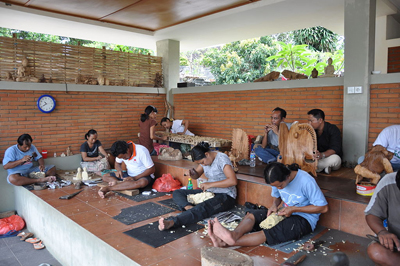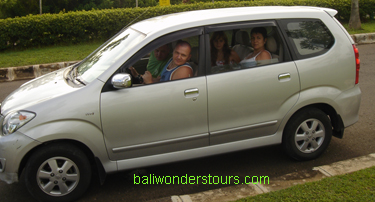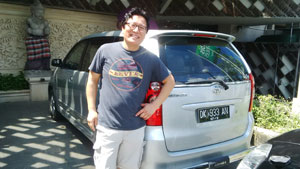Bali Art and Craft
18 September 2012In Bali, the concept of viewing sculpture as an independent art from and of artists pursuing one’s creative ideas independently s quite recent. In historical times, sculptors to express their creativity. Instead they worked for courts and communities as specialist craftsmen or carvers of stone and wood to produce works that depict religious myths and beliefs. Religious use and function dictated what these craftsmen produced in terms of the shape, design and material used in their work.
Panels depicting scenes from human life or hell had to be set on walls in the inferior and impure (nista) part of the temple whilst figures of the gods were kept in shrines located in the purest part of the temple (utamal). Before a Sculptor could start work on carving they had to choose a propitious day and time. Furthermore, they could only use a material endowed with religious meaning, this excludes the use of some types of wood. Sometimes a priest has to initiate the start of the carving process to endow the material with proper religious content. Balinese temples, whether new or those centuries old are adorned with mythical creatures, spiritual guardians and narrative scene from the Ramayana. Balinese culture and sculpture are not two different ends of the poles but a continuum. Hindu art is an imitation of life and history.

The pre-dominance of religious carving did not preclude the existence of sculpture and carving that was non religious. Relief and panels, particularly in their lower part, as well as some masks, invariably show an astonishing creativity and liberty in style and content. To this should be added the richness and sometimes the humor of decorative elements of walls, doors or roofs and utensils such as krisses or betel sets, often depicting part of the real animal and natural life or grotesque human figures. This popular and even sometimes vulgar side of Balinese classical art was a pool of form and ideas that played a major role in the evolution of Balinese carving toward its present state.
The Dutch take over of southern in Bali in I 960-1908 not only destroyed the traditional courts of the island but it also shattered the old system of the arts and the artists made works that were commodities instead of item of religious use or content. This has an important impact on the production of carvings that could now be made with free themes and content. It was during this era Bali was “discovered” by Western artists whose influence would give a new turn to evolution of its arts. Several of them chose to reside in Ubud, in particular Walter Spies (1895-1942) and Rudolf Bonnet (1895-1978). With the support of the princes of the Sukawati House of Ubud, they set to encourage the budding renewal of sculpture and painting, distributing material and guiding the artists with advice and criticism. The Westerners also functioned as dealer, channeling Balinese works to international connoisseurs. In a matter of years the production had grown to such an extent that an association was set up to guide the renewal movement through more official channels. This was the Pita Maha association (1936-1942), a guild of Balinese plastic art, whose mane has now become identical with the renewal movement. The renewal of sculpture that took place in the late 1920’s was both thematic and aesthetic. The first themes which came to the mind of Balinese carvers once they did not work for religious purposes were depictions of elements of their daily life, people sitting drinking from a pitcher, resting , squatting, talking. The Balinese started looking at themselves with a new “candid” eye. Soon, however a stylistic evolution took place. The first one led to invention of the sleek style. Walter Spice apparently evoked it in 1929, whilst he has commissioning two woodcarvings from the Blaluan sculptor I Telaga Blaluan, who gave him a lengthy piece of wood he had lust obtained for this purpose. To his Surprise I Telaga did not cut the piece of wood in :wo as ordered but produced instead an elongated work. Associated with a sleek working of wood a style was born. Much of the future evolution of Balinese sculpture would consist in playing with natural proportions, first elongating them, then , after the war, shortening them, producing the style still in favour today. There were several masters of sculptures.
For wooden masks, the most famous villages are Singapadu, Mas and Batuan. Jewellery, mostly silver and gold was traditionally practiced by a clan of specialist craftsmen the Pande Bralan and to this day they are considered to be endowed with magical power. Traditional makers of Balinese kriss, they now make modern jewellery aimed at the tourist market e.g. bracelets, necklaces, rings and broaches. The best shop s are located in the villages of Celuk although some have now opened outlets in Ubud, Kuta and Sanur. Bali with its world famous traditional music, has many workshop where many bronze and bamboo instruments used in the local orchestra are made. The gongs come from Java. Batubulan near Gianyar, Tihingan to the north of Klungkung and Sawan in Singaraja are home to specialized smiths. The musicians themselves often make bamboo instruments. The Balinese also make beautiful dance costumes, with sophisticated headdresses made of mother of pearl and or flower and leather. These costumes, although made all over the island are best found in the Sukawati Batuan area. There, the craftsmen paint the golden prada motif of the dancer apparels.
Bali is also a shopper’s paradise for the best handicraft product from all over Indonesia: pottery from Lombok, leather works from Java, weaving from lesser Sunda island, batik from Java, colonial furniture from Madura and eastern Java, basket from Borneo and much more.
Bali Best Quote
Why rent a car in Bali?
- Bali Car Rental Self drive with wide range of well maintained fleet
- Rent a car with Bali tour driver
- Bali Car charter, price already included car, Bali tour driver and petrol. Our tour driver will be happy to drive for you as per your own itinerary in Bali Island.


| For mor information please feel free to contact Rent Car Bali.net | |
| Hotline | local 085737187321 |
| overseas: +62 85737187321 | |
| 6285737187321 | |















